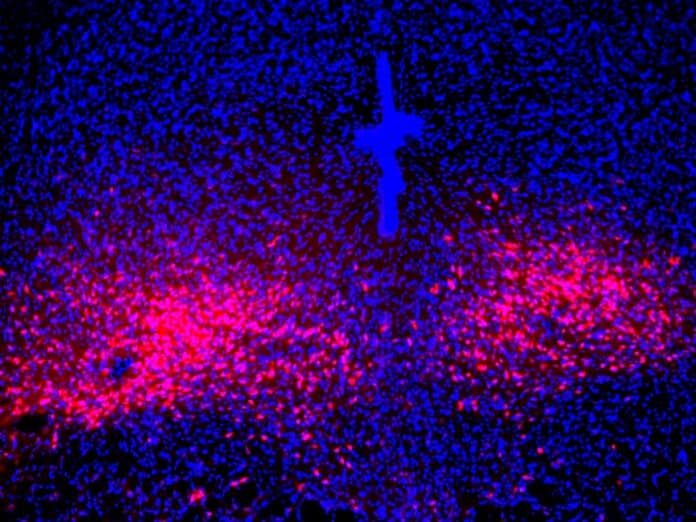Panic disorder is marked by overwhelming fear and physical symptoms that set it apart from other anxiety disorders. The specific neural mechanisms responsible for these distinct symptoms are not fully comprehended.
To enhance panic disorder treatments, Salk researchers are working on mapping the brain regions, neurons, and connections involved in panic attacks. They’ve identified a specific brain circuit responsible for panic disorder, which affects specialized neurons transmitting and receiving a neuropeptide called PACAP. Notably, they’ve identified PACAP and the neurons producing its receptor as potential targets for developing new treatments for panic disorder.
Senior author Sung Han, associate professor at Salk, said, “Previously, we thought the amygdala, known as the brain’s fear center, was mainly responsible—but even people who have damage to their amygdala can still experience panic attacks, so we knew we needed to look elsewhere. Now, we’ve found a specific brain circuit outside of the amygdala that is linked to panic attacks and could inspire new panic disorder treatments that differ from currently available panic disorder medications that typically target the brain’s serotonin system.”
To start outlining a map of the brain related to panic disorder, researchers examined the lateral parabrachial nucleus (PBL) in the pons, a part of the brainstem known as the “alarm center.” Interestingly, this small brainstem area controls panic and regulates breathing, heart rate, and body temperature.
The researchers observed that the PBL likely generated panic and triggered emotional and physical changes. Additionally, they discovered that the PBL produces a neuropeptide called PACAP, a key regulator of stress responses. The team turned to a mouse model of panic attacks to validate and expand their proposed map.
Co-first author Sukjae Kang, senior research associate in Han’s lab, said, “Emotional and stress-related behaviors have been associated with PACAP-expressing neurons in the past. By mimicking panic attacks in the mice, we were able to watch those neurons’ activity and discover a unique connection between the PACAP brain circuit and panic disorder.”
During a panic attack, the researchers observed that PACAP-expressing neurons became activated. Once activated, these neurons release PACAP neuropeptide messengers to another part of the brain called the dorsal raphe, where neurons with PACAP receptors are located. The released PACAP messengers activated these receptor neurons, manifesting panic-related behavioral and physical symptoms in the mice.
Establishing this connection between panic disorder and the PACAP brain circuit marked a significant advancement in mapping panic disorder in the brain, according to Han. The team also noted that inhibiting PACAP signaling could disrupt the flow of PACAP neuropeptides and reduce panic symptoms, offering a promising avenue for the future development of panic disorder-specific therapeutics.
Senior author Sung Han, associate professor at Salk, said, “Despite panic disorder’s categorization as an anxiety disorder, there are many ways that anxiety and panic are different—like how panic induces many physical symptoms, like shortness of breath, pounding heart rate, sweating, and nausea, but anxiety does not induce those symptoms.”
“Or how panic attacks are uncontrollable and often spontaneous, while other anxiety disorders, like post-traumatic stress disorder (PTSD), are more memory-based and have predictable triggers. These differences are why it is critical to construct this panic disorder brain map so that researchers can create therapeutics specially tailored to panic disorder.”
“We found that the activity of PACAP-producing neurons in the brain’s parabrachial nucleus is inhibited during anxiety conditions and traumatic memory events—the mouse’s amygdala actually directly inhibits those neurons.”
“Because anxiety seems to be operating conversely to the panic brain circuit, it would be interesting to look at the interaction between anxiety and panic since we need to explain now how people with anxiety disorder have a higher tendency to experience panic attacks.”
The researchers are enthusiastic about investigating PACAP-expressing neurons and PACAP neuropeptides as potential new targets for panic disorder medications. They also aim to expand their map of panic disorder in the brain by exploring where the neurons producing PACAP receptors in the dorsal raphe send their signals, and how other brain regions related to anxiety interact with the PACAP panic system.
Journal Reference:
- Kang, S.J., Kim, JH., Kim, DI. et al. A pontomesencephalic PACAPergic pathway underlying panic-like behavioral and somatic symptoms in mice. Nat Neurosci (2024). DOI: 10.1038/s41593-023-01504-3
